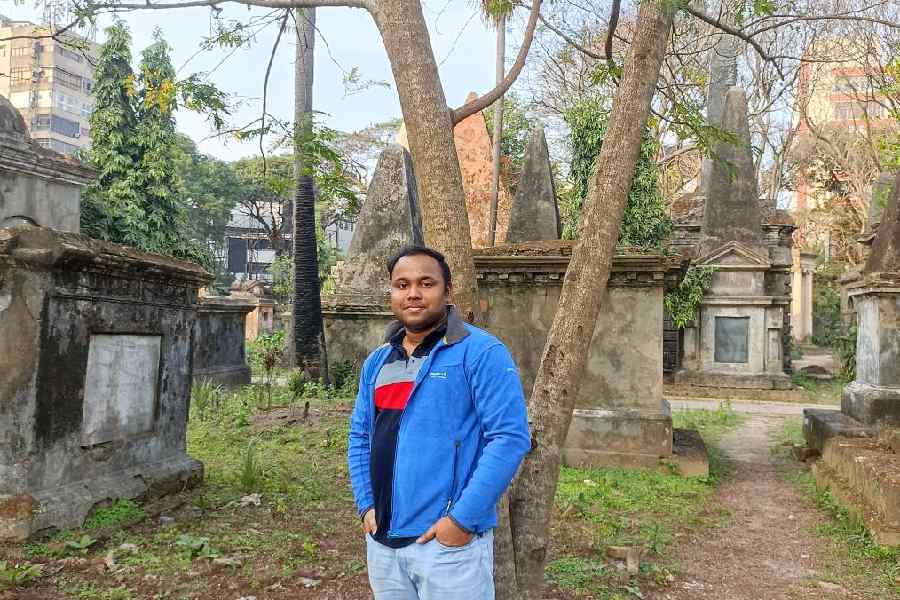You would be mistaken if you think that the South Park Street cemetery (SPSC) is the oldest European cemetery in Calcutta, for that distinction belongs to the St John’s churchyard, much of which was levelled in a demolition drive in 1802. The Job Charnock mausoleum in the churchyard is still paved with surviving tombstones.
After SPSC, which opened in 1767 and hastily closed in 1790 (although reopened soon and used till 1839), why did grandiose mausoleums fall out of favour and humbler memorials were opted for?
Actually, the mortality was so high and the “tomb culture” so trending, the cemeteries were filling up rapidly, leading to the Bengal government in 1813 to rule: “The dimensions of a Monument are not to exceed the abovementioned sizes, without the special sanction of the Select Vestry, whose duty it should be to limit the spaces to be occupied in the Burying-ground.”
These are two amazing little-known facts, among others, revealed in Anirban Bhadra’s book Pompous Graves: A History of the Park Street Cemeteries of Calcutta, published last year.
London-based historian Rosie Llewellyn-Jones, reviewing Bhadra’s book in Chowkidar, the journal of the British Association for Cemeteries in South Asia (BACSA), writes: “Pompous Graves is packed full of relevant photographs and maps which have been diligently uncovered by Bhadra…. The book is not only the first detailed history of the Park Street cemeteries, it is well-written, informative and with a touch of humour too — a final chapter on ‘Looking for the Paranormal’ is instructive”.
Originally, there were four cemeteries on Park Street. Three have been lost to rapid urbanisation — North Park Street cemetery and the Mission cemetery went in 1953 and Tiretta’s cemetery in 1977. The Apeejay School, Assembly of God Church and a hospital came up on the plots.
SPSC, bursting at its seams, was left unharmed because of its historical significance, though even in the late 1980s land sharks had not stopped eyeing it. Only after 1978 did concerted efforts at restoration begin with the formation of the BACSA in the UK, which sponsors and urges local groups in India to maintain the colonial cemeteries.
SPSC was BACSA’s maiden venture and it has succeeded considerably, so far, thanks to the Christian Burial Board, the sole guardian and caretaker of Calcutta’s Christian cemeteries, both open and closed, since 1881.
But why would Bhadra, from Santragachhi in Howrah, be fixated on sifting through the graves of long-dead and forgotten white men and women? He is neither a scholar (he is still studying for graduation at an open university) nor a historian.
Bhadra himself states he comes from a humble background and went to a Bengali-medium school in Santragachhi, where he lives with his parents. By his own admission, he is neither well-read nor fond of reading.
He attributes this to his Anglophilia, which he developed during his college days and which has remained, in varying degrees, with him ever since. “I am whimsical. I cannot explain why I leaned towards English customs and culture. I even wanted to convert to Christianity but later abandoned the thought,” says Bhadra, in his 20s.
In earlier times, Bengalis used to listen to the BBC Radio to learn English as she is spoken. Similarly, Bhadra would stream popular British sitcoms and comedy sketches on the Internet. He chose to read British history books at the British Council library instead of his college texts. He learnt everything under his own steam. After higher secondary, he took up random jobs but couldn’t last as he disliked the dull routine. Now his only source of income is private tuition. Instead of a regular job, his only desire is to establish himself as a historian of British Calcutta and British India.
Like any young Bengali, his first encounter with a colonial cemetery was in one of Satyajit Ray’s popular detective novels, Gorosthane Sabdhan, set in SPSC.
He was in Class X then and had hardly imagined he would research its history someday. He visited SPSC for the first time in 2017 and was enchanted. He began reading the staple works available on Calcutta’s history. “I had noticed there is no proper documented history of SPSC. The majority of the few available discussions so far are about the notables interred there with little about the cemetery itself. This spurred me to fill the vacuum,” Bhadra said. The research took him an entire year.
Printed in Calcutta, the BACSA publication has done well in the UK and garnered positive reviews, but in Calcutta, no regular bookshop stocks it. “The cemetery authority has been very kind to sell copies from the gatehouse, and most copies are sold out; they are expecting a restock,” says Bhadra.






